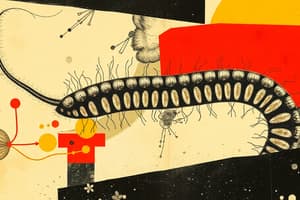Podcast
Questions and Answers
How do nematodes contribute to ecosystems?
How do nematodes contribute to ecosystems?
- By causing soil erosion
- By competing with plants for nutrients
- By hunting large prey
- By breaking down organic matter and recycling nutrients (correct)
What is a key characteristic of nematodes?
What is a key characteristic of nematodes?
- Segmented body
- Smooth, non-jointed cuticle (correct)
- Hard, exoskeleton structure
- Jointed cuticle
What is the reproductive nature of nematodes?
What is the reproductive nature of nematodes?
- Sexual reproduction only
- Asexual reproduction only
- No reproductive organs
- Hermaphroditic (correct)
How do nematodes impact plants?
How do nematodes impact plants?
What is a common control method for nematodes?
What is a common control method for nematodes?
How do nematodes impact livestock and humans?
How do nematodes impact livestock and humans?
What is the first stage of the nematode life cycle?
What is the first stage of the nematode life cycle?
Which rainfall zone in Australia is associated with a uniform (non-seasonal) rainfall pattern?
Which rainfall zone in Australia is associated with a uniform (non-seasonal) rainfall pattern?
In the nematode life cycle, what stage involves larvae that can survive in the environment but are not yet infective to their host?
In the nematode life cycle, what stage involves larvae that can survive in the environment but are not yet infective to their host?
What has been a common traditional strategy to control parasitic nematodes?
What has been a common traditional strategy to control parasitic nematodes?
What is one of the negative impacts of using chemically synthesized compounds to control nematodes?
What is one of the negative impacts of using chemically synthesized compounds to control nematodes?
Which of the following is a new eco-friendly strategy for controlling nematodes mentioned in the text?
Which of the following is a new eco-friendly strategy for controlling nematodes mentioned in the text?
Flashcards are hidden until you start studying
Study Notes
Nematodes: Characteristics, Ecology, Economic Impact, Life Cycle, and Control Methods
Nematodes, also known as roundworms, are the most abundant metazoan organisms on Earth. These tiny, cylindrical creatures are found in various ecosystems, including soil, water, and organic-rich substrates. There are approximately 100,000 species of nematodes, with over 20,000 known species in terrestrial environments. Some of the most important nematodes include those that parasitize plants, livestock, and humans.
Characteristics
Nematodes are characterized by their slender, cylindrical shape and unsegmented body. They have a smooth, non-jointed cuticle and a soft, paddle-like tail that helps them move through their environment. Nematodes are typically less than 1 centimeter long, but some species can reach up to 1 meter. They are hermaphroditic, meaning they have both male and female reproductive organs, and they reproduce sexually.
Ecology
Nematodes are found in a variety of environments, including soil, water, and organic-rich substrates. They play a critical role in ecosystems, serving as decomposers that break down organic matter and recycle nutrients. Nematodes also serve as a food source for higher trophic levels, such as birds and other animals.
Geographical Distribution
Nematodes are distributed worldwide, with different species found in various climates and ecosystems. In Australia, nematodes are distributed according to the three main rainfall zones: summer, winter, and a non-seasonal (uniform) rainfall zone. Different species of nematodes have varying distributions within these zones, with some species more common in specific rainfall zones.
Economic Impact
Nematodes can have significant economic impacts, particularly in agriculture and livestock industries. Parasitic nematodes can cause severe deterioration in the health of crops and livestock, leading to enormous economic losses. The traditional strategy to control these parasites has been based on chemically synthesized compounds, such as pesticides and anthelmintic drugs. However, these compounds can have negative impacts on the environment, affecting the soil's beneficial microbiota and leaving toxic residues in agricultural crops and animal products.
Life Cycle
Nematodes have a complex life cycle that involves multiple stages, including the embryonic stage, free-living larvae, and parasitic stages. The life cycle of nematodes can vary depending on the species and their environment.
Stages of the Life Cycle
- Unembryonated egg: This is the first stage of the life cycle, where the egg is laid by the adult male or female nematode.
- Embryonated egg: This stage occurs when the egg has developed into an embryo, which can hatch into a larva.
- Pre-infective larvae: These larvae are not yet infective to their host, but they can survive in the environment for some time.
- Infective larvae: These larvae are capable of penetrating and infecting their host.
Control Methods
Controlling nematode populations is crucial for maintaining healthy ecosystems and reducing economic losses. Traditional control methods include chemical control using pesticides, crop rotation, planting resistant crop varieties, fallowing, and soil amendments. However, these methods can have negative impacts on the environment and may lead to the development of drug-resistant nematode populations.
New Strategies of Control
Researchers have been exploring new, eco-friendly strategies for controlling nematodes, such as the use of natural nematode enemies. These natural enemies can help control nematode populations without the negative environmental impacts associated with chemical control methods. One such strategy involves the use of nematode antagonistic organisms, which can be used for biocontrol of nematodes. These organisms can be applied to the soil or plants to control nematodes and reduce the need for chemical control methods.
Studying That Suits You
Use AI to generate personalized quizzes and flashcards to suit your learning preferences.




